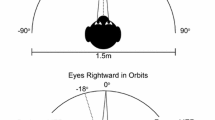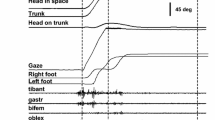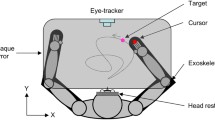Abstract
Most studies of rapid orienting gaze shifts generated by combined eye and head movements have focused on an experimental condition in which gaze displacements are started with the subject's eyes in the normal straight-ahead position in the orbit. Such an experimental approach does not permit a clear identification of the input signal to the head motor system, because target offset angle is the same for both the eye and head. We have studied gaze shifts in human subjects which began with the visual axis straight ahead relative to the body (i.e., gaze or line of sight aligned with body sagittal plane) and with head offset from straight ahead at various angular positions. In our experimental conditions, the amplitude of head movement during a gaze shift was nearly equal to the angular distance between the target position and the starting head position (target-re-head), even though subjects were not specifically instructed to move their heads. This observation contrasts with other published reports in the literature showing considerable varibility amongst subjects in the amplitude of head rotation within a given task and between tasks. The difference may be related to the initial conditions which required subjects to align the eye and head on specific starting targets, since others have shown that requiring head alignment enhances head displacement. The amplitude of the saccadic eye movement was not determined by either the target's position relative to the starting eye or head positions. The value that best described the eye movement amplitude was the eye position in the orbit at the end of the saccade. This was nearly equal to target-rehead until a saturation eye position in the orbit was attained.
Similar content being viewed by others
References
Afanador AJ, Aitsebaomo AP (1982) The range of eye movements through progressive multifocals. Optomet Month 73:82–88
Bard C, Fleury M, Paillard J (1992) Head orienting and aiming accuracy. In: Berthoz A, Graf W, Vidal P-P (eds) Head-neck sensory-motor system. Oxford University Press, New York, pp 582–586
Barnes GR (1979) Vestibulo-ocular function during coordinated head and eye movements to acquire visual targets. J Physiol (Lond) 287:127–147
Becker W, Jürgens R (1992) Gaze saccades to visual targets: does head movement change the metrics? In: Berthoz A, Graf W, Vidal P-P (eds) Head-neck sensory-motor system. Oxford University Press, New York, pp 427–433
Biguer B, Prablanc C, Jeannerod M (1984) The contribution of coordinated eye and head movements in hand pointing accuracy. Exp Brain Res 55:462–469
Bizzi E (1981) Eye-head coordination. In: Brooks VB (ed) Handbook of physiology, sect 1, vol II, The nervous system. American Physiological Society, Bethesda, MD, pp 1321–1336
Delreux V, Vanden Abeele S, Lefevre P, Roucoux A (1991) Eye-head coordination: influence of eye position on the control of head movement amplitude. In: Paillard J (ed) Brain and space. Oxford University Press, New York, pp 38–48
Fuller JH (1992a) Comparison of head movement strategies among mammals. In: Berthoz A, Graf W, Vidal P-P (eds) Head-neck sensory-motor system. Oxford University Press, New York, pp 101–112
Fuller JH (1992b) Head movement propensity. Exp Brain Res 92:152–164
Funk CJ, Anderson ME (1977) Saccadic eye movements and eyehead coordination in children. Percep Motor Skills 44:599–610
Galiana HL, Guitton D (1992) Central organization and modelling of eye-head coordination during orienting gaze shifts. Ann NY Acad Sci 656:452–471
Gresty MA (1974) Coordination of head and eye movements to fixate continuous and intermittent targets. Vision Res 14:395–403
Guitton D (1992) Control of eye-head coordination during orienting gaze shifts. Trends Neurosci 15:174–179
Guitton D, Volle M (1987) Gaze control in humans: eye-head coordination during orienting movements to targets within and beyond the oculomotor range. J Neurophysiol 58:427–459
Guitton D, Munoz DP, Galiana HL (1990) Gaze control in the cat. Studies and modelling of the coupling between eye and head movements in different behavioural tasks. J Neurophysiol 64:509–531
Land MF (1992) Predictable eye-head coordination during driving. Nature 359:318–320
Ron S, Berthoz A (1991) Eye and head coupled and dissociated movements during orientation to a double step visual target displacement. Exp Brain Res 85:196–207
Tomlinson RD, Bahra PS (1986) Combined eye-head gaze shifts in the primate. I. Metrics. J Neurophysiol 56:1542–1557
Volle M (1988) Contributions a l'etude des coordinations oculocephaliques chez l'homme et l'animal. PhD thesis, McGill University
Zangemeister WH, Stark L (1982a) Types of gaze movement: variable interactions of eye and head movements. Exp Neurol 77:563–577
Zangemeister WH, Stark L (1982b) Gaze latency: variable interactions of head and eye latency. Exp Neurol 75:389–406
Author information
Authors and Affiliations
Rights and permissions
About this article
Cite this article
Volle, M., Guitton, D. Human gaze shifts in which head and eyes are not initially aligned. Exp Brain Res 94, 463–470 (1993). https://doi.org/10.1007/BF00230204
Received:
Accepted:
Issue Date:
DOI: https://doi.org/10.1007/BF00230204




